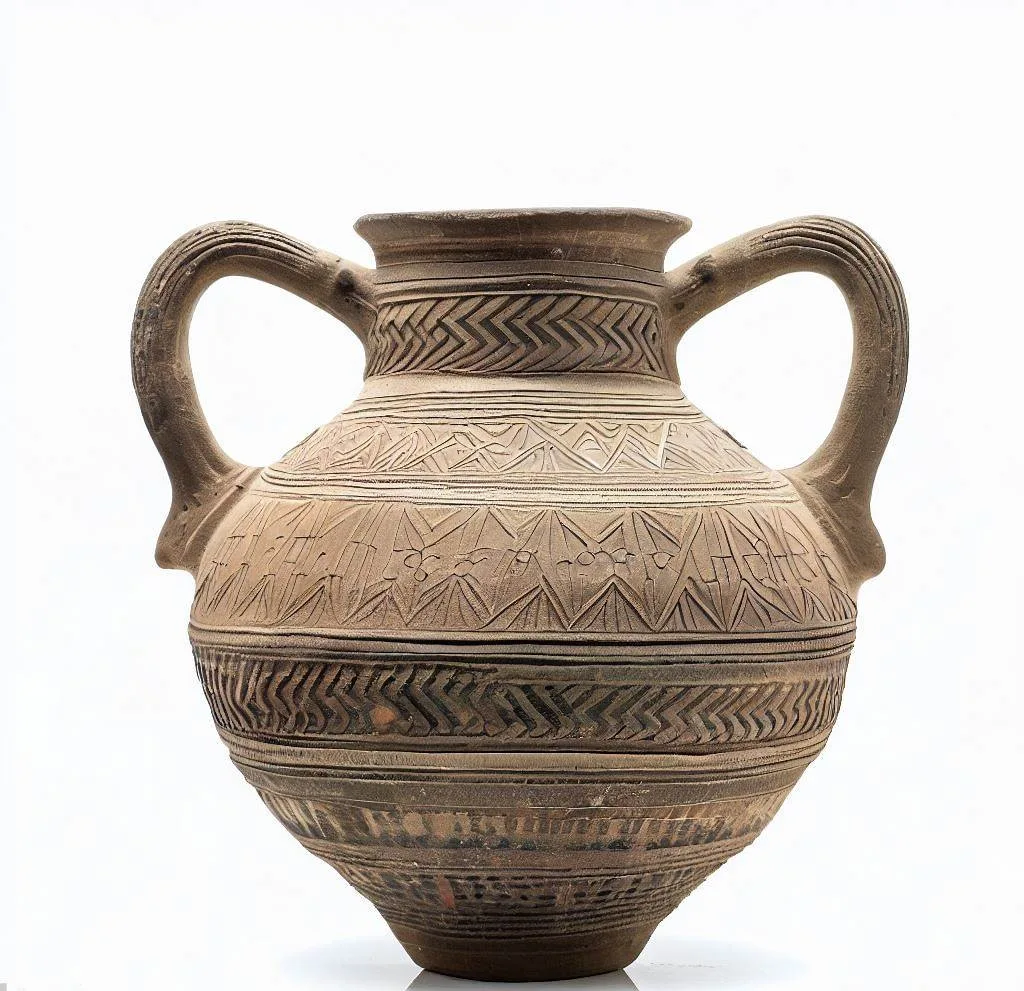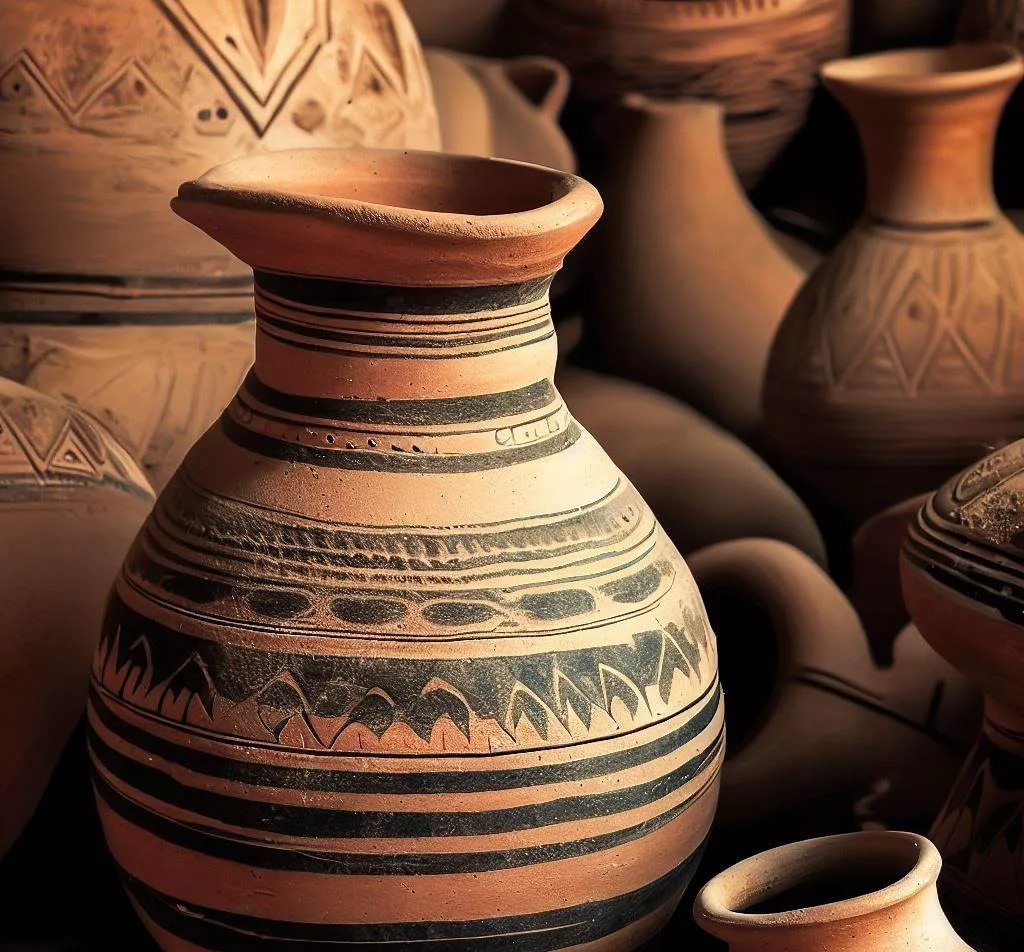History buffs get ready to discover the ancient beauty of Phoenician Pottery. From stunning designs to incredible durability, these artifacts have stood the test of time.
Phoenician pottery is a type of pottery that originated in the ancient Phoenician civilization, which flourished from around 1550 BC to 300 BC in the eastern Mediterranean region. Phoenician pottery is notable for its distinctive designs and colors, as well as its significance in trade, artistic expression, and religious practices.
Types of Phoenician Pottery

Decorative Pottery
Phoenician decorative pottery was often used for display purposes and featured intricate designs and patterns. These designs were usually painted onto the pottery using black, red, or white colors, and often included geometric shapes, animals, and human figures.
Amphorae
Phoenician amphorae were used for storing and transporting liquids such as wine, oil, and milk. These vessels were typically tall and narrow, with two handles for carrying. The designs on Phoenician amphorae were often simpler than those on decorative pottery, with the focus being on functionality rather than aesthetics.
Bowls and Plates
Phoenician bowls and plates were used for serving food and featured designs similar to those found in decorative pottery. These vessels were often larger and wider than amphorae and were designed to be displayed on tables and in homes.
Storage Jars
Phoenician storage jars were used for storing and transporting grains, oils, and other dry goods. These jars were typically round or cylindrical in shape and featured simple designs.
Read About: 7 Famous Historical Phoenicians of All Time
Characteristics of Phoenician Pottery

Materials Used in Phoenician Pottery
Phoenician pottery was typically made from clay and was fired at high temperatures to create a durable, long-lasting product. The clay used in Phoenician pottery was often mixed with other materials such as sand, shells, or crushed pottery to increase its strength and durability.
Phoenician Pottery Designs
Phoenician pottery designs were often inspired by nature and included animals, plants, and other natural motifs. The designs were usually painted onto the pottery using a variety of techniques, including brushwork, stamping, and incising.
Phoenician Pottery Colors
Phoenician pottery was often painted using a limited color palette that included black, red, and white. These colors were derived from natural sources such as iron oxide and were often used in combination to create intricate patterns and designs.
Read About: 10 Remarkable Discoveries of Phoenician Artifacts
Significance of Phoenician Pottery

Trade
Phoenician pottery was a valuable commodity in the ancient world and was traded extensively throughout the Mediterranean region. Phoenician pottery was known for its durability and strength, which made it ideal for transporting goods long distances. In the late Iron Age, a new kind of Phoenician container emerged, rising quickly to commercial prominence: the famed transport jar. These vessels underwent complex morphological and functional changes over time, becoming highly sought after for their unique properties. From the 8th century onward, Phoenician jars represented a valuable export from south Lebanon, shipped to various Southern Levantine destinations, Egypt, Cyprus, and even as far as the western Mediterranean. These jars played a crucial role in the earliest Phoenician holdings in the West, such as those found in Iberia, and were a testament to the remarkable trading prowess of the ancient Phoenicians.
Artistic Expression
Phoenician pottery was also used as a means of artistic expression and was often adorned with intricate designs and patterns. Phoenician potters were skilled craftsmen who used a variety of techniques to create their pottery, including wheel throwing, and glazing.
Religious Significance
Phoenician pottery also held religious significance for the ancient Phoenicians. Many Phoenician vessels were decorated with religious symbols and were used in religious rituals and ceremonies.
Read About: Who Were the Phoenician People in the Bible?
Techniques Used in Phoenician Pottery

Wheel Throwing
Phoenician potters also used the wheel-throwing technique to create their pottery. This involved shaping the clay on a spinning wheel to create a symmetrical vessel. Wheel throwing allowed for greater consistency in size and shape, and also allowed the potter to create more complex designs and patterns.
Glazing
Phoenician potters used a variety of glazes to decorate their pottery. These glazes were applied to the pottery after it had been fired and were used to create a smooth, shiny surface. Glazes were often made from natural materials such as ash or clay and were applied in a thin layers to create a range of colors and textures.
Read About: Secrets of the Scythian’s Burial Mounds
Famous Examples of Phoenician Pottery

Cypriot Pottery

Cypriot pottery is a type of Phoenician pottery that was produced on the island of Cyprus during the 8th century BC. Cypriot pottery is known for its intricate designs and patterns, which often include animals, plants, and geometric shapes. Cypriot pottery was highly valued in the ancient world and was traded extensively throughout the Mediterranean region.
Phoenician Pottery from Sarepta

Phoenician pottery from Sarepta is a type of Phoenician pottery that was produced in the ancient city of Sarepta, which is located in modern-day Lebanon. Phoenician pottery from Sarepta is known for its distinctive red and black designs, which often include animals and geometric shapes.
Phoenician Pottery from Tyre

Phoenician pottery from Tyre is a type of Phoenician pottery that was produced in the ancient city of Tyre, which is also located in modern-day Lebanon. Phoenician pottery from Tyre is known for its intricate designs and patterns, which often include animals, plants, and other natural motifs.
Questions Related to Phoenician Pottery
What materials were used to make Phoenician pottery?
Phoenician pottery was typically made from clay and was fired at high temperatures to create a durable, long-lasting product.
What were Phoenician amphorae used for?
Phoenician amphorae were used to transport goods such as wine, olive oil, and other commodities throughout the ancient Mediterranean world.
How were Phoenician designs and patterns created on pottery?
Phoenician designs and patterns were created using a variety of techniques, including wheel throwing, and glazing. These techniques allowed Phoenician potters to create intricate and detailed designs on their pottery.
What was the religious significance of Phoenician pottery?
Phoenician pottery held religious significance for the ancient Phoenicians, and many vessels were decorated with religious symbols and used in religious rituals and ceremonies.
The discovery of ancient Phoenician 2,900-year-old earthenware pottery in Tire, Lebanon, has shed light on the religious beliefs and practices of this ancient civilization. These vessels were more than just containers; they held immense religious significance and were used in various rituals and ceremonies. The jars found at the site were used to store the bones of the dead after their bodies were burned, with the larger jars functioning as individual tombs and the smaller ones symbolically representing the souls of the deceased. Thanks to the tireless work of teams like Ali Badawi and the Spanish team from Pompeu Fabra University, we can continue to piece together the habits and traditions of this fascinating civilization.
What is the significance of the preservation of Phoenician pottery?
The preservation of Phoenician pottery is important as it provides insights into the ancient Phoenician civilization, including their trade practices, artistic expression, and religious beliefs. The surviving examples of Phoenician pottery are valuable artifacts that help us understand the ancient Mediterranean world.
Ignite your personal growth journey with our handpicked collection of inspiring content. Sign up now for a life-changing dose of motivation and wellness.






